
image by Jose C. Alegria, 29 June 2000

Last modified: 2013-01-19 by rob raeside
Keywords: italy | sport | football | soccer | cispadane republic | ferrari | formula one |
Links: FOTW homepage |
search |
disclaimer and copyright |
write us |
mirrors
See also:
Other Sport Flags:
Other Sites:
The (light) blue is the color of Savoia. It was used for the Previous President's flag (blue with
the coat-of-arms of the Republic in gold).
Giuseppe Bottasini
That blue colour is the livery colour of the House of Savoy,
and therefore for the Kings of Italy 1861-1946.
Elias Granqvist, 13 August 2001
There is Italian flag which is like the Somali flag
but with darker shade of blue. It is the Azzurro
[sky blue] of the Italian sky with the white star
representing Italy ("Lo Stellone"). It is
probably taken from the Italian coat of arms
but I am not sure about that.
Those flags are often seen on soccer
stadiums and can also be charged with from one to many stars. All our
sport teams wear shirts with the blue color and white colour on
their shorts. We call our teams "Azzurri" because of
it. On many newspapers, especially in relation
with soccer championships, there are
logos representing Italy, using
the Azzurro and white or
even golden stars instead of the tricolor flag [but
sometimes do including it].
Francesco Santangelo, 2 January 2007

image by Jose C. Alegria, 29 June 2000
I just finished watching the second semi-final in european cup
of football, where Italy won on the penalty series (lucky
"azzurri"). The reason of this, is to show a flag I
found interesting among the Italian crowd. It´s the national
flag of Italy with 3 blue stars for the 3 world cups they hold.
Jose C. Alegria, 29 June 2000
Today at the swimming pool I saw an Italian silver medalist
holding a tricolore but with some kind of emblam on the white
stripe. I try to take a look over and over but unfortunally the
TV was consantrated on the winner so I couldn't see the emblam in
its whole.
From what I could see it was a circle made of two branches of
something (laurel ?) and inside the circle a unclear device and
the letters R and C. The emblam was all blue.
My guess that it is some Italian sport emblam (swimming
federation ?).
Dov Gutterman, 17 November 2000
the flag saw by Dov Gutterman is the Cispadane Republic's flag adopted by
Massimiliano Rosolino silver medalist as lucky charm.
Luca Secomandi, 24 September 2000
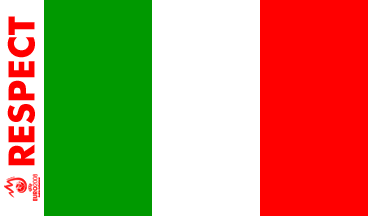
image by António Martins-Tuválkin, 2 July 2008
"RESPECT" flags distributed by UEFA to the
supporters. Those "RESPECT" national flags have a
vertical white stripe added along the hoist, charged with the
emblem of the Championships and "RESPECT". The emblem
can be seen in full colours on the Euro2008 official
website.
Ivan Sache, 28 June 2008
1) 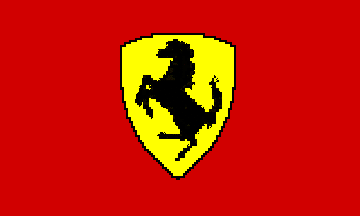
image by Theodore Leverett, 9 October 2000
2) 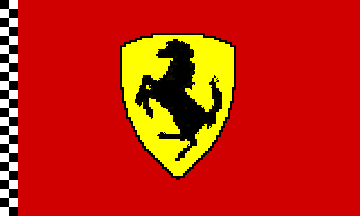
image by Theodore Leverett, 9 October 2000
3) 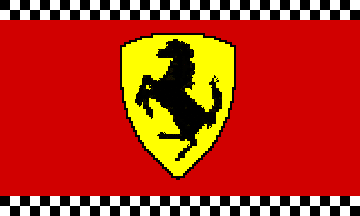
image by Theodore Leverett, 9 October 2000
4) 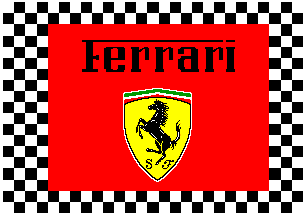
image by André Serranho, 12 December 2000
In footage of the celebrations for Michael Schumacher's
clinching of the Formula One championship for Ferrari (first for
that company in 21 years) by winning the Japanese Grand Prix, I
saw several types of flag being waved:
1) plain red flag with the Ferrari prancing horse badge in the
center;
2) same as (1), with two rows of alternating black and white
squares (checkered flag pattern) along the hoist;
3) same as (1), with checkered flag pattern along the upper and
lower edges of the flag.
Some of the celebrants at Maranello, Italy, home of Ferrari, were
also waving Italian flags.
Theodore Leverett, 9 October 2000
Near Ovelgönne (Kreis Wesermarsch, Niedersachsen (Lower
Saxony), Germany), I "sailed" on ferry with a Ferrari
flag, with a double blocked border and the name above the shield.
This may have been alternative 4 above.
Peter Hans van den Muijzenberg, 28 August 2001
Official Flag of Ferrari
The official flag is a yellow one with the black horse at the
center. We are flying on the gate gardian building as many of
such flags as the victories we scored this year up to now. On the
other buildings there are also red flags with our shield amid,
alternating the yellow one.
Concerning the other flags quoted above you can see them and
others at ferrarimerchandiseshop
site.
Pier Paolo Lugli, 9 October 2000
The sign with the black horse on yellow was originally the
sign of a cavallry regiment, and was used by the Italian flying
ace Fransesco Baracca in the First World War. Baracca was shot
down and killed in 1918. Enzo Ferrari knew Baracca's father, and
they decided after the war that Ferrari could use the horse as a
mark on the cars of his racing team. It was used for the first
time at the 24 hour race at Spa in 1932. When Ferrari started to
build his own cars, the sign with the horse of course followed.
The sign is used in a shield form on racing cars and in a
rectangular form on cars sold to the public; above the horse is a
chief (to use a heraldic term) horizontaly divided in the colours
of the Italian flag - green, white and red - and to each side of
the horse in the lower part is often the letters S and F, for
Scuderia Ferrari, the name of Enzo Ferrari's racing team.
(I got most of this information from a Swedish book series on
cars published in the 1980's, called Cars Collection.)
Elias Granqvist, 8 January 2001
There is a portrait of Jean Todt, head of Ferrari´s formula 1
racing team, on Eurosport tonight. Todt shows Ferrari flags
outside the Ferrari office. Each year they put up one flag for
every race won, and this year, it has been a bit difficult for
them to have room for all the flags, since they won so many
races.
The flags were hanging down because of lack of wind, but as far
as I could see the flags were of the kind we have on our site,
all yellow with the black horse.
Elias Granqvist, 14 December 2002
Here is the Italian system for swimming conditions:

image by Ivan Sache, 29 January 2004
A red flag means that swimming is dangerous and unadvised.

image by Ivan Sache, 29 January 2004
A red flag over a yellow flag mean that watching has stopped (from 18:30 to 9:30 the next day).

image by Ivan Sache, 29 January 2004
A yellow flag means that watching is limited (from 13:30 to 15:30).
My source; the website of an Italian sea resort <www.balnearilido.it>,
does not mention a green flag which would, logically, be used to
signal non-dangerous and watched swimming conditions.
Ivan Sache, 29 January 2004
This page was set up by the beach management of Lido di
Camaiore, in Camaiore, in Lucca province, which doesn't mean that the
system described is used only in the beaches of this commune.
António Martins-Tuválkin, 11 September 2007
According to <www.salvamento.info>
all flags are rectangular:
- White: "saving service in action".
- Yellow: "danger because of the wind; it's dangerous to
keep sunshades opened or to use or play with inflatable
devices".
- Red: "it's dangerous to go for a bath because of bad
meteorological conditions; it's dangerous to use vessels or
inflatable dinghies; it's forbidden to borrow pedal-boats, boards
or anything similar".
- Checkered blue and white: "No lifesaving service (usually
from 13.00 to 14.30)".
Jan Mertens, 4 December 2006
This website includes in Italian much more information than is
does for English or German: It additionally says that the yellow
flag is rarely used and that the red flag is used when it rains
or when the sea is choppy, or both. This therefore is not a
hierarchical system of increasing danger.
A checquered flag is hoisted to indicate that the lifeguard not
on duty (lunch time), probably similar to Portuguese use.
This page quotes for its flag information the regulation for
beach safety issued by the Emilia-Romagna
regional government (along with some ironical comments about the
publics' perception of beach flags!), but, again, that doesn't
mean that the system described is used only in the beaches of
this region.
António Martins-Tuválkin, 11 September 2007
The WTO 2001 big book on tourism signage [Lqr01] quotes an IFTO survey (40-42)
stating that Italy uses "no flag for safety, yellow for
caution, red for danger", wich matches neither of the above
(except for the colors). The same book, however, lists only a red
flag for danger, and none other, as an "WTO survey"
(also p. 40- 42).
António Martins-Tuválkin, 11 September 2007